Two months ago, we posted the 2019 edition of our Golf Ball Survey. This is the second time we’ve done a ball survey and the first since 2015. Suffice to say, we got a lot more responses this time around.
The idea was to get a better idea of why you play the golf ball you do (or maybe why you don’t much care what ball you play). Along the way, we covered brand (and model) preferences, ball fitting, and the growing direct to consumer market. Frankly, we got a little deeper into the mud than we planned, but what’s a little dirt in the interest of a greater understanding, right?
For each chart, I’ve included my general observations along with some of my interpretations. I would encourage you to draw your own conclusions and share those thoughts in the comment section.
Before we move on, just a couple of quick notes:
- I didn’t want to get into the demographics stuff too much, so for those who are interested, I’ve put a gallery of those charts inline farther down in this post.
- For those curious about sample size, these charts reflect data collected from just over 7000 (7009 to be exact) completed surveys.
Winner Winner
Before we jump into the data, we need to announce the winner of the 6 dozen Bridgestone balls offered up as an incentive to take this survey.
Congrats, Keith A. We’ll be in touch.
With that out of the way, let’s dig into the data.
Survey Data & Analysis
Technically, this probably still qualifies as a demographics question. The chart pretty much speaks for itself. It looks like our bell curve is centered in the 5-6 dozen per year. That sounds about right for no other reason than it’s about how many I go through. It’s reasonable to assume that better golfers go through less and that golfers who live in climates that allow for year-round play likely go through a few more.
If you’re not buying golf balls, you’re probably either playing what you find, or not playing golf. Neither of those sounds particularly awesome to me.
This is about what I’d expect given that golf ball prices aren’t’ particularly fluid. The takeaway is that the typical MyGolfSpy reader isn’t merely looking for cheap. Just under $50 is what most pay for Pro V1s, while the company’s primary competitors tend to sell for a bit less.
Experienced shoppers know that buying in bulk can drive prices down. That’s especially true in the direct to consumer space where bulk pricing puts Snell and Vice under the $30 mark for their urethane offerings.
Not surprisingly, Titleist leads the field by a significant margin. Nearly 80% of respondents say they’ve played a Titleist ball within the last year. If you’re a play what you find kind of golfer, chances are you play a lot of Titleist.
TaylorMade and Bridgestone hold a slight advantage over Callaway and Srixon. After that, there’s a significant drop-off to Snell, Vice, and Kirkland, before dipping into the sub-10% range for most of the rest of the field.
Among the 4.58% who chose the Other option, TopFlite, Pinnacle, Inesis, Nike, MG, Seed, and Noodle were the popular choices.
Noodle? Seriously?
Apologies for the clutter. We wanted to give you as much opportunity as we reasonably could to tell us what your preferred golf ball model is. It shouldn’t be surprising that the #1 Ball in Golf (Pro V1/Pro V1x) is your top choice, but I’ll admit to being surprised by the size of the gap (nearly 3x that of your #2 choice).
Looking at the 2nd tier, Srixon was next among our readers- narrowly edging out TaylorMade. Snell’s MTB/MTB X and Bridgestone’s Tour BX/BX S line were preferred by 8.41% and 7.62%, respectively. This is one of those cases where what our readers choose doesn’t align with the market as a whole. It’s a bit of a surprise for me that Callaway, the #2 ball on the market, isn’t particularly popular with our readers. That’s plenty justified given what we uncovered during and after our ball test, but it’s surprising to see the degree to which it trails brands it leads in the broader market.
Looking beyond Snell in the direct to consumer space, Vice, Kirkland (this survey was closed before the ball launched), and to a lesser degree MaxFli (the Dick’s house brand), are more popular than offerings from more mainstream golf brands like Wilson, Mizuno, and Volvik.
Among those who selected Other, Inesis’ Tour 9000, Srixon’s Soft Feel and AD333 were popular choices. It’s also worth noting that obsolete balls like the Titleist NXT Tour, Nike RZN, and Bridgestone e6 series were mentioned several times each.
Just about anyone who knows anything about golf balls and golf ball performance will tell you that you should play the same ball for every shot all season long. Most of us do a little bit of experimenting each year, which is to be expected, but how often are we keeping our favorite ball in play?
More than 10% of you say you play your preferred ball 100% of the time, while the biggest chunk, say their favorite ball is in play 90-99% of the time. Plus or minus a rounding error or two, that gives us about 50% of respondents playing their preferred ball at least 80% of the time, while about 9% play their favorite ball less than half of the time.
This question may be worth exploring further in a separate post. It would be interesting to see what correlations exist between preferred ball usage and handicap or preferred ball usage and ball model. For example, are better golfers more inclined to play their preferred ball more often? What about brand loyalty? Do golfers who favor Pro V1/Pro V1x players play it with more regularity than golfers who favor Callaway?
A greatly simplified version of the previous question, we wanted to see how often you moved between golf balls. Not surprisingly, a substantial majority play several different ball models over the course of a season. It’s also not surprising that nearly 11% report playing multiple models over the course of a round. Let’s stop doing that.
We wondered about the extent to which golfers think about who is actually responsible for the technology in the golf balls they buy. The mainstream golf ball OEMs all have a library’s worth of patents. Dean Snell’s experience (and IP) in the ball business is well-documented too. After that…things start to fall off.
As golfers may or may not be aware, while the overwhelming majority of Direct to Consumer balls are more accurately characterized as Indirect from the Factory offerings. The actual design, engineering, and manufacturing are typically done by one of a growing number of ball factories in Asia, while the retailer of record is responsible only for the logo, packaging, and most importantly, the marketing. More often than not, the guys telling those stories are selling a stock factory product, know next to nothing about designing a golf ball, and hold exactly zero patents in the golf ball space. The pitch by many Direct to Consumer ball brands is that they eliminate the middleman. In reality, they are the middleman.
How much does any of that matter to golfers shopping for a decent ball at a reasonable price?
For the biggest chunk of you, the answer is not even a little. Nearly 40% of you think it’s somewhat important, though I suspect a good deal trumps most everything else. Almost 18% of you said it’s very important. Does that mean you won’t play a ball made by someone without any golf ball IP?
Big-box stores, which include places like Dick’s and PGATour Superstore, account for the highest percentage of ball sales. Online (from the manufacturer or direct to consumer) is next at just under 21%. That covers everything from direct to consumer brands, to mainstream brands mirroring the DTC model. Online golf specialty retailers are just above 10%. Traditional golf shops (both green grass and off-course) are hanging in there, while I suspect Amazon is going to continue to grow and will one day soon surpass those traditional channels.
Among those who selected other, Walmart, Costco, and Lostgolfballs.com were mentioned most often.
One of the things we often hear from golfers is that “I’m not good enough to tell the difference between golf balls.” So, we wanted to get a better sense of how pervasive that sentiment is. Encouragingly enough, only 5% said that, from what they can tell, all golf balls are the same. A significantly higher percentage said that they can only tell the difference between urethane and surlyn balls. That suggests that a large segment of golfers (roughly 41%) doesn’t believe they can tell the difference between tour-quality balls. And again, this is data from our readers. Across all golfers, I suspect that the number is significantly higher.
Whether that’s ability-driven or speaks to the reality that golfers don’t always know what to look for is unclear.
Just under 60% of respondents believe they can discern performance differences between golf balls.
What’s notable here is that the MyGolfSpy reader appears significantly less likely to play a non-white ball than a typical consumer.
+/- 20% is what most tell us the percentage of non-white balls is across the market as a whole. We’re closer to 16%. Some of that likely comes from a lack of Truvis play (since few of you reported playing Callaway balls). I’d also wager that the typical MyGolfSpy reader is more inclined to play a tour-quality ball. While most everyone is offering something other than white within the category, the breadth of color choices isn’t nearly what it is within the 2-piece/surlyn space.
Given how concerned readers often are about what clubs Pros are playing, it’s initially surprising that less than 4% of you say you won’t play a ball that isn’t played by professionals. My hunch is that this is the necessary byproduct of the growth of the direct to the consumer market.
If your perspective is that you’ll only play brands that are played on tour, you’ve effectively limited your selection to 5 brands while committing to pay +/-$40 for a dozen balls. I’d also wager that this speaks to the degree to which golfers believe they can discern performance differences between balls. Golfers are much more reticent to play clubs that aren’t used on tour, and nearly everyone says they can tell the difference between the club they bought and the ones they didn’t. With balls, it appears to be mostly the opposite.
Cost almost certainly plays a role here as well. The performance specifications of many direct to consumer balls don’t vary wildly from those from the mainstream brands. Quality differences are challenging to quantify, but cost differences can be significant. Take all of that and pair it with the perception that those cost differences are directly attributable to big brands paying professionals to play their product, and it’s easy to understand why validation at the professional level isn’t a concern for 71% of you.
DEMOGRAPHICS
Before we delve into Ball Fitting and Direct to Consumer offerings, let’s pause briefly to look at the demographics of the readers who participated in this survey. I’ll spare you the commentary on these charts. As a reminder, just a bit more than 7000 golfers completed this survey.
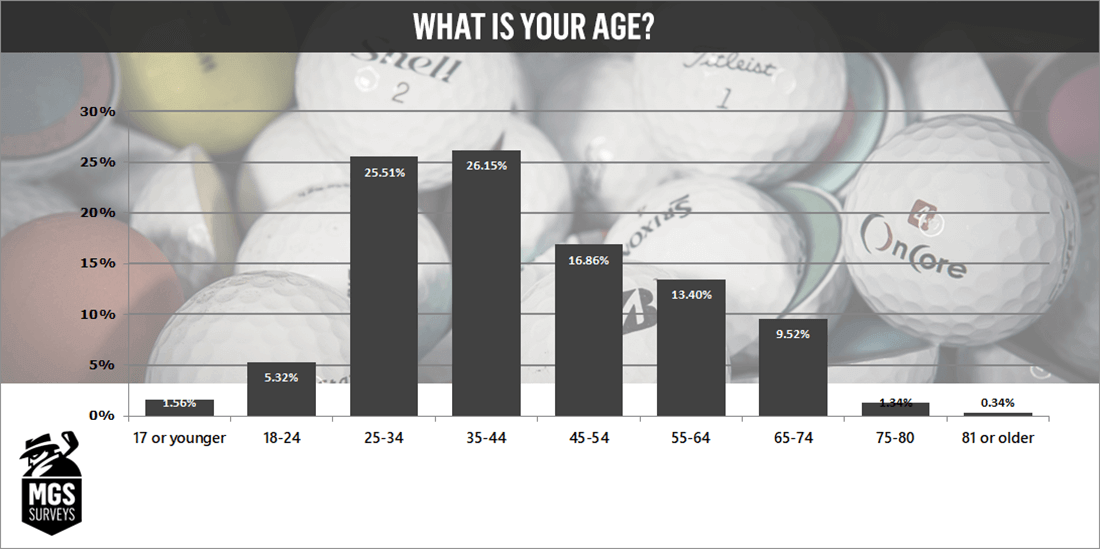
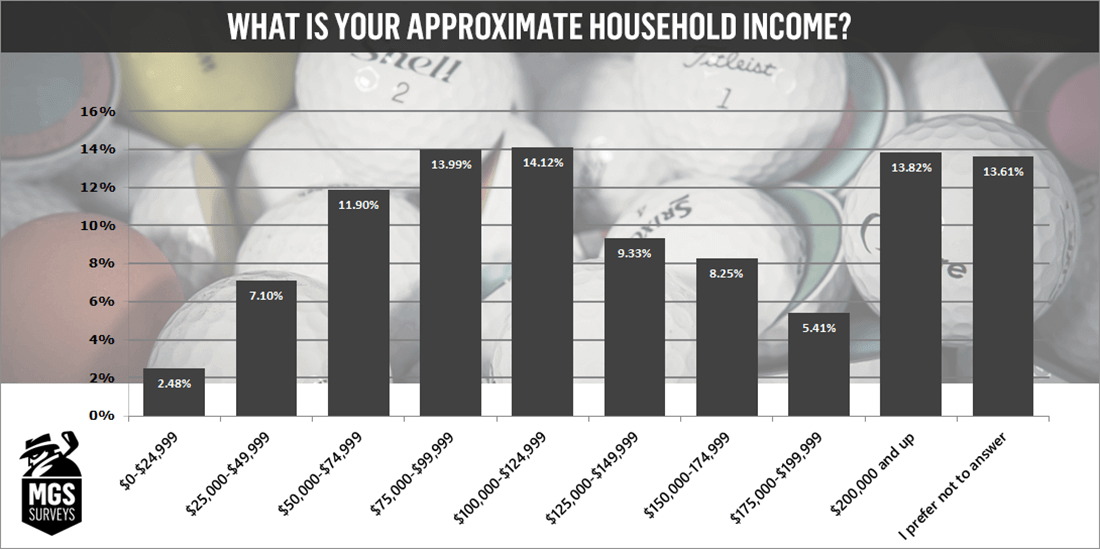


Ball Fitting and Direct to Consumer Use
We’ve talked a lot about the importance of ball fitting (it DEFINITELY matters), so we wanted to gauge your perceptions on the importance of ball fitting relative to club fitting.
I’ve gone back and forth in my head on this several times. I could make an argument that it’s more important than club fitting, but from a cause and effect perspective, it makes sense to me that if you can’t consistently deliver the club, you’re not going to come close to maximizing the potential of the golf ball.
With that in mind, I find myself agreeing with the 71% of you thing ball fitting matters a bit less than club fitting. While I’m typically not a fan of speaking about any aspect of fitting in absolutes, I will say that the 6.72% of you who think that golf ball fitting is unimportant are absolutely wrong.
This question is plenty straightforward. Just a bit less than half of you have been fit (in some capacity) for a golf ball. Those of you who answered YES were presented with additional questions so we could learn a bit more about your golf ball fitting experience.
Among those of you who report being fitted for a ball, more than 50% were fitted online. It’s a start.
Demo days and fitting events account for the lion’s share of in-person fittings. I suspect ball fitting will see the most growth among custom club fitters (textbook win/win situation), while big-box will, no doubt, look to capitalize on what should prove to be a growing trend.
It’s one thing to get fit for a ball; it’s another to play it.
Roughly 60% of you are still playing the ball you were fit for. For those who told us you weren’t playing the ball you were fit into, we asked a simple follow-up: Why?
Switched to something else or something better likely explains 90% of the equipment decisions we make.
As you’d expect, price is a factor, with nearly 20% saying the ball they were fit into was too expensive. Performance and Feel were also mentioned quite a bit in the comments by those who chose the other option.
Other factors mentioned by respondents include a lack of availability in their local proshop, poor wind performance, and a lack of short game spin. I suppose those last ones fall under performance as well.
The most interesting of the frequently mentioned reasons for not playing the ball you were fit for is that the fitting was limited to a single brand. This speaks to the current lack of brand agnostics ball fitters. Titleist fits for Titleist, Bridgestone fits for Bridgestone (though historically they’ve admitted when their ball isn’t the best for a given golfer), Callaway reps fit for Callaway, and so on down the list it goes.
Custom club fitters are beginning to get in on the action, and as the availability of brand-agnostic ball fitting increases, golfers should be happier with the results, and less inclined to wonder if what they’re fit into is the best ball for them or just the best option from a particular manufacturer.
Direct to Consumer Balls
Another fork in our survey’s road. We wanted to take a closer look at Direct to Consumer golf ball usage.
For what it’s worth, we last ran a golf ball survey in 2015. At the time, the percentage of respondents who had tried a direct to consumer ball was effectively zero. Just a bit more than 4-years later, nearly 50% report having purchased direct to consumer balls.
The golf ball space is full of well-established brands that make quality, high-performing products. So why are golfers looking elsewhere?
Surprise, surprise (not really), it’s primary cost. When bulk pricing for a reputable direct to consumer balls isn’t much more than half the price of a dozen of the #1 ball on the market, it’s easy to understand the appeal.
I also understand wanting to support the little guy, especially if you’re inclined to believe that the big guy has been taking advantage of you for years.
My 2 cents here, I think Better is generally a poor adjective to qualify ball performance. Unless we’re talking about a quality/consistency metric different is almost always a more apt descriptor. You’d also have a tough time selling me on Superior Tech and Innovation. Perception vs. reality and whatnot – where are the patents? Similar tech for less, sure, but we didn’t give you that option.
Among the others, Curiosity and some flavor of the Price/Performance equation were cited most often.
One last fork in the road.
44.37% (of our original 43.91% who’ve purchased a DTC ball) report that they’re still playing a DTC ball. That earned you an extra question.
The response from our readers suggests that there are currently only two serious players in the direct to consumer space. Snell accounts for more than 67% of DTC usage among respondents, while Vice is less than half of that. OnCore is the only other brand above 5%, though we should again mention that this survey was conducted between major Kirkland ball releases. If Costco fixes the problems with the new 4-piece, I would expect it to be a top-3 DTC brand.
Kirkland, Inesis, and MG were listed most often by those who selected Other.
Currently, no Direct to Consumer ball is produced in the USA. As you’ll see in a moment, country of origin doesn’t factory highly in the ball buying decision matrix, but I would curious to see if a DTC ball produced in the USA would have the potential to move the needle.
Prefaced with the fact that I’m typically one who takes measures of interest in hypotheticals with a grain of salt, I can’t ignore that 80%+ of you are somewhat to very interested in an imaginary direct to consumer ball that’s made in America.
It could be fun…or it could be nothing.
This is inarguably the most meaningful question in the survey. In straightforward terms, it’s a means to try and understand what you’re looking for in a golf ball.
To recap: Respondents were asked to rank each option in order from Most to Least important. If an option wasn’t a consideration, survey takers would able to select NA.
Across all responses, Quality Control/Consistency was rated as the most important factor. That’s interesting since it’s difficult to quantify, and what consumers know about quality is mostly (though not exclusively) anecdotal. I agree that Quality/Consistency should be, far and away, the most important factor in the ball buying decision. The challenge in that is, again, that it’s tough to know who is actually producing a high quality and consistent product and who isn’t.
As I would have expected, Feel and Greenside Spin were next on the list, followed by Driver Distance and Iron Performance. Three of those things impact your score, one of them doesn’t – and not for anything, if you care about Greenside Spin, don’t play a ball with an ionomer/surlyn cover.
Where things get interesting (to me anyway) is when we look at Forgiveness and Price.
My perspective is that, as it relates to a golf ball, the notion of forgiveness is mostly bullshit. We can dig into that in more detail if the interest is there, but there’s certainly no universally accepted metric. That gives manufacturers plenty of room to play fast and loose with a word that suggests more benefit than it actually delivers.
We’ve already established that price is the primary reason why golfers are choosing DTC balls in increasing numbers, and yet, in the grand scheme of things, it’s not among the top reasons why golfers choose a given ball. What I think that means is that price matters, but not to everyone, and not to the same degree.
Within the bigger picture, Brand Name, Color/Graphics, and Country of Manufacturer appear to play little role in the buying decision, though I suspect Brand Name is more important than respondents admit.
This chart presents a different look at the previous question. The first chart shows the average relative importance in a single bar, while this one examines the rate at which each choice fell on our 10-step ranking ladder.
For example, that bit of green on the top right shows us that Country of Manufacture was rated as the 10th most important factor 26.6% of the time, and was not a factor at all (NA) 28.04% of the time.
There are a few things that stand out with this visualization.
- While Quality Contro/Consistency had the highest average rating, it’s notable that its position is driven almost entirely by how often it was selected as the most important consideration (1). 26.71% of golfers rated it first. When it’s not the most important consideration for golfers, it’s less of a consideration in general.
- Feel, while not selected as the most important factor as often, is almost always a factor. Golf companies know this and they’ve leveraged it to sell you balls that feel good (often to the detriment of your game). While plenty of golfers prefer a softer feeling (and inherently slower) golf ball, responses to other questions in the survey suggest that too soft can also be a problem. It’s a bit of a Goldilocks problem. There’s no universal just right for every golfer, but if you swing faster than 80MPH, you should think about how much you’re willing to give up off the tee and how much spin you’re willing to sacrifice on your iron shots for a preference that rarely has a performance upside.
- Curves for Driver Distance, Greenside Spin, and Iron Performance are similar, though Greenside Spin appears to be the most important of the group. As long as we’re not at the extremes, with spin typically comes control. The highest spinning ball may not be the best for you; you want a ball that produces enough spin. With that in mind, stop playing 2-piece Ionomer balls. In terms of smart decision making, I think the order of importance across the entire chart is pretty much spot on.
- Color, country of manufacture, and brand name follow similar curves as well. None of them appear to factor heavily in the buying decision. I suppose you can call these value-added features. It’s nice to have color options, some of us like particular brands, and many appreciate it when a ball is made in the USA. All good things, but none a significant-enough reason on its own to buy a ball.
Have Your Say
In general, a lot is going on here, and I’d be interested to hear your takeaways from these last two charts and the survey as a whole.
Be sure to share your thoughts below, and if you have any ideas for future surveys, please share those as well.



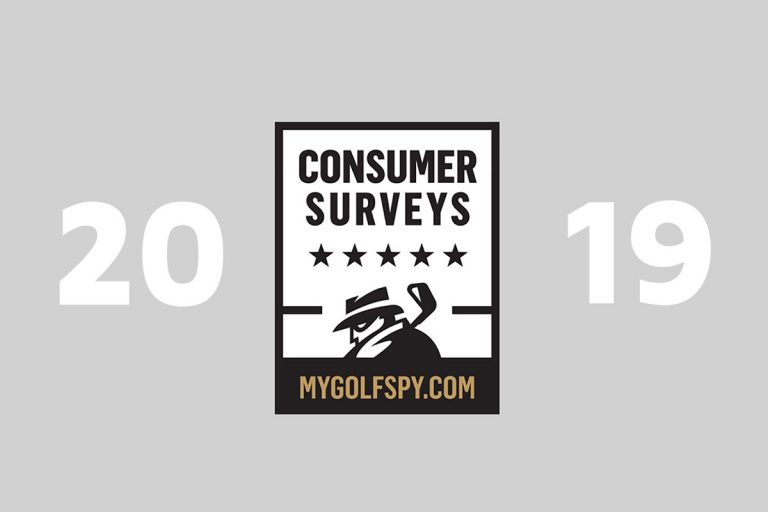











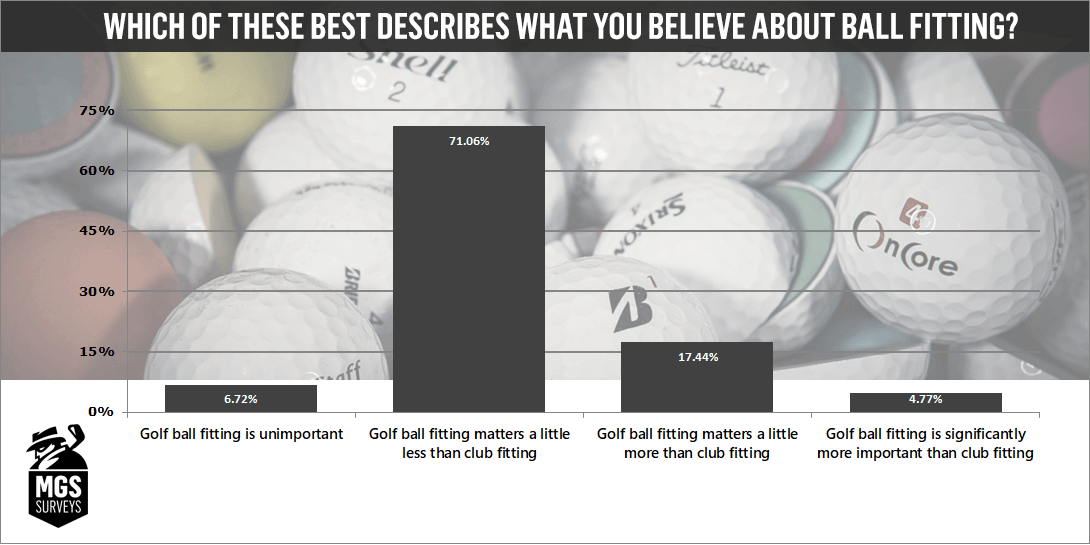






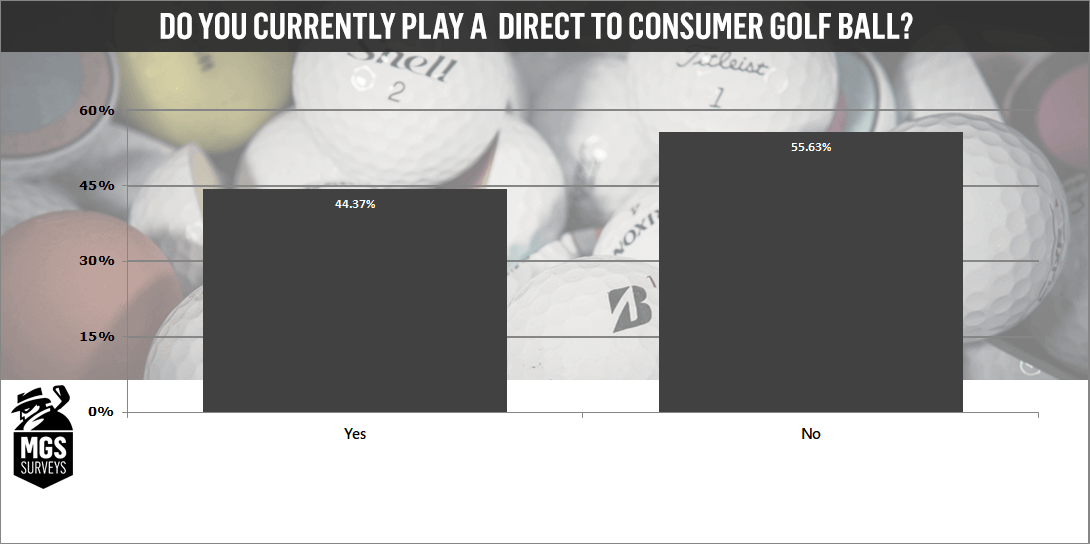














scott
4 years ago
I call this Scott science, The Pro v is a great ball but I’ll never pay retail price $45 a dozen ( I find them ) the low end ball $20. a dozen roll out to much on most greens.. I find them too. The medium price ball $35 a dozen seem to work well for my game. I find them too. The moral of Scott science is you buy the golf balls and I find them here’s where the science come in and I recycle them and save the earth from Global warming. . ..The only problem is I have about 4000 golf ball in my garage because I find more ball then I lose